
Genista canariensis is a species of flowering plant in the legume family Fabaceae, known by the common names Canary broom, Canary Islands broom or florist's genista. It is native to the Canary Islands, but it grows as an introduced species in mainland Europe, especially Spain, and on other continents. It has been introduced to California and Washington State in the US. This is a vigorous upright evergreen shrub growing to 3 m (9.8 ft) tall by 1.5 m (4.9 ft) broad, with hairy green stems. The leaves are made up of oval-shaped blue-green leaflets each up to a centimeter long and densely hairy on the undersides. The raceme inflorescence holds up to 20 bright yellow pea-like flowers. The fruit is a legume pod one to two centimeters long containing several dark brown seeds.
Ivesia argyrocoma is a species of flowering plant in the rose family that is also known by its common name, silverhair mousetail. It is native to the San Bernardino Mountains of southwestern San Bernardino County, California. A population of Ivesia argyrocoma is also found in Baja California in Mexico; this population may or may not be distinct and further study is required. Ivesia argyrocoma is a small perennial herb producing a clump of fuzzy reddish naked stems that grow horizontal to the ground and a number of tail-like hairy leaves which grow erect and may curl or droop. The stems are 10 centimetres (3.9 in) to 20 centimetres (7.9 in) long. Each leaf is a nearly cylindrical strip of tightly overlapping leaflets arranged around a central rachis up to 8 centimetres (3.1 in) long. The leaflets are green and covered in a dense coat of shiny silver hairs. Most of the leaves emerge from the base of the stem; a few very small ones may emerge farther up the stem. At the tip of the stem is an inflorescence of one or more clusters of glandular flowers. Each flower has generally five green and red, densely silver-haired, triangular sepals and five smaller oval or spoon-shaped white petals. The center of the Ivesia argyrocoma flowers contain twenty yellow-anthered white stamens and several pistils. The fruit is a tiny smooth brown achene.

Allium tuolumnense is a rare species of wild onion, known by the common name Rawhide Hill onion.
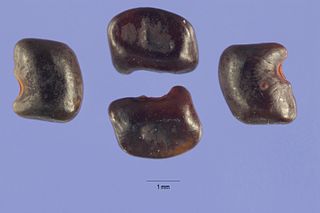
Aeschynomene rudis is a species of flowering plant in the legume family known by the common name zigzag jointvetch. It is native to South America but it is known from other continents, including North America, as a noxious weed, especially of wet areas such as rice fields. It is aquatic or semi-aquatic, growing bristly, glandular stems near or in water. It grows up to two metres tall. The leaves are composed of oval-shaped leaflets each about a centimetre long. At the base of each leaf are large, flat, pointed stipules. The flower is purple-tinted white and 1 to 1.5 centimetres wide. The fruit is a lobed, gland-dotted legume pod narrowed between the seeds. It is up to 5 centimetres long and less than one wide. As the pod dries it breaks into segments, each segment containing a seed. The hard, shiny seed is kidney-shaped and 2 or 3 millimetres long.

Allium cratericola is a species of wild onion known by the common name Cascade onion. It is endemic to California, where is an uncommon member of the flora in several of the state's mountain ranges, including the northern and southern California Coast Ranges, the western Transverse Ranges, Klamath Mountains, and the Sierra Nevada foothills. Its range covers much of the state, from Riverside County to Siskiyou County.

Astragalus brauntonii is a rare species of milkvetch known by the common name Braunton's milkvetch. It is endemic to California, where it is known from fewer than 20 extant occurrences in the hills and mountains surrounding the Los Angeles Basin in Southern California. This is a federally listed endangered species in the United States.
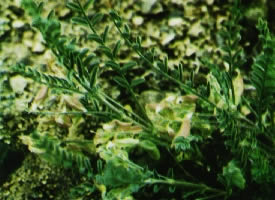
Astragalus johannis-howellii is a species of milkvetch known by the common name Long Valley milkvetch. It is native to eastern California, including Long Valley in Mono County, and its distribution extends over the border into Nevada. It is a plant of the Great Basin's scrub habitat.

Astragalus oophorus is a species of milkvetch known by the common name egg milkvetch. It is native to the western United States, mainly California and Nevada, though one variety can be found as far east as Colorado. It is a plant of sagebrush and other dry habitat.

Astragalus pomonensis is a species of milkvetch known by the common name Pomona milkvetch. It is native to Baja California and southern California, where it can be found in a number of coastal habitats, including the California Coast Ranges. This is a bushy perennial herb forming a clump of thick, hollow stems up to about 80 centimeters tall. Leaves are up to 20 centimeters long and are made up of many oval-shaped leaflets each up to 3 centimeters in length. The inflorescence is a large array of up to 45 cream-colored flowers. Each flower is between one and two centimeters long. The fruit is a bladdery legume pod which dries to a thin, almost transparent papery texture. It may exceed 4 centimeters in length and generally drops off the plant when dry.

Astragalus webberi is a rare species of milkvetch known by the common name Webber's milkvetch. It is endemic to the coniferous forests in the Sierra Nevada, in Plumas County, eastern California.

Lupinus cervinus is a species of lupine known by the common name Santa Lucia lupine. It is endemic to the Santa Lucia Mountains in the Central Coast Ranges in California, where it is an uncommon member of the flora in the mountain forests. This is a hairy gray-green perennial herb growing up to 30–70 centimetres (12–28 in) tall. The erect stem is surrounded by clusters of spreading leaves. Each palmate leaf is made up of 4 to 8 leaflets up to 8 centimetres (3.1 in) long and 3 centimetres (1.2 in) wide, which is wider than the leaflets of most lupines. The inflorescence bears many flowers, sometimes in whorls, each between 1 centimetre (0.39 in) and 2 centimetres (0.79 in) long. The flower is often bright pink, but may be shades of blue to nearly white. There is often a yellow patch on the banner. The fruit is a hairy legume pod up to 6 centimetres (2.4 in) long.
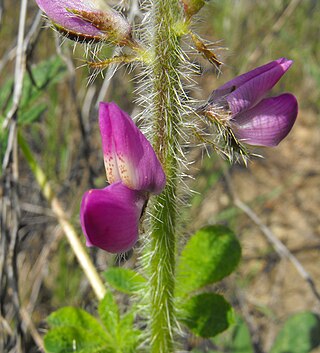
Lupinus hirsutissimus is a species of lupine known by the common names stinging annual lupine or stinging lupine. It is native to the coastal mountains of Baja California and Southern California as far north as the San Francisco Bay Area. It grows on dry mountain slopes, including areas that have recently burned, and chaparral and woodlands habitats.
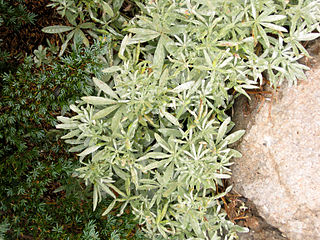
Lupinus obtusilobus is a species of lupine known by the common name bluntlobe lupine. It is native to high mountains of northern California, including the North Coast Ranges, the Klamath Mountains, and the northernmost Sierra Nevada. It grows in various types of mountain habitat, sometimes carpeting meadows with its purple blooms in the spring. It is a perennial herb growing erect or decumbent along the ground, its stem 15–30 centimetres (5.9–11.8 in) long. Each palmate leaf is made up of 6 to 7 leaflets up to 5 centimetres (2.0 in) long. The herbage is coated in silvery silky hairs. The inflorescence is a small raceme with a few whorls of flowers each just over a centimeter long. The flower is blue to purple with a yellowish patch on its banner. The fruit is a silky-haired legume pod up to 4 centimetres (1.6 in) long.
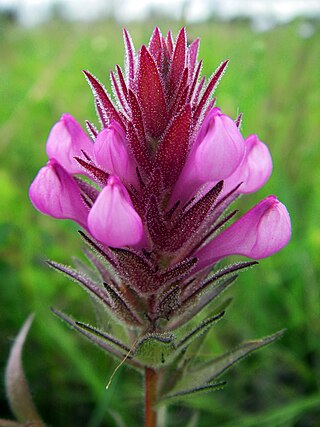
Orthocarpus bracteosus is a species of flowering plant in the broomrape family known by the common name rosy owl's-clover. It is native to western North America from British Columbia to northern California, where it grows in moist mountain habitat, such as meadows.

Pedicularis attollens is a species of flowering plant in the family Orobanchaceae known by the common name little elephant's head lousewort. It is native to Oregon and California, where it grows in moist mountainous areas such as meadows and bogs. It is a perennial herb growing up to 60 centimetres (24 in) in maximum height with one or more stems emerging from a caudex. The leaves are comblike, divided into many linear lobes. The inflorescence is a raceme occupying the top of the stem. The sepals of the flowers and the bracts between them are woolly. The flower is under 1 centimetre long and divided into a curving trunklike upper lip and a three-lobed lower lip. It is pink or purplish in color with darker stripes. The fruit is a capsule up to 1 centimetre long containing seeds with netlike surfaces.
Pedicularis howellii is an uncommon species of flowering plant in the family Orobanchaceae known by the common name Howell's lousewort. It is endemic to the Siskiyou Mountains of the Klamath Range in southern Oregon and northern California, where it grows on the edges of coniferous forests. This is a perennial herb producing one or more stems up to 45 centimetres (18 in) tall from a long caudex. The leaves are up to 20 centimetres (8 in) long, lance-shaped, and divided into many toothed oval lobes; those higher on the stem may be unlobed. The basal leaves fall away early. The inflorescence is a small raceme of flowers occupying the top of the stem. Each white to light purple flower is up to one centimetre long and is sickle-shaped, with a curved beak-like upper lip and a three-lobed lower lip which may be tucked into the hairy mass of sepals. The plant is pollinated by bumblebees including Bombus mixtus. Between the flowers are hairy to woolly triangular bracts. The fruit is a capsule just under a centimeter long containing seeds with netted surfaces.
Pediomelum castoreum is a species of flowering plant in the legume family known by the common names beaver Indian breadroot and beaver dam breadroot. It is native to the deserts around the intersection of California, Nevada, and Arizona, where it grows in local habitat including disturbed areas. It is a perennial herb with no stem or a short stem that is mostly underground, leaving the plant at ground level. The compound leaves are each made up of five or six oval leaflets which may be over 4 centimeters long. The leaf is borne on a long petiole. The inflorescence is a raceme of several blue or purple pealike flowers each roughly a centimeter long. The fruit is a hairy oval legume pod tipped with a long, curved beak. It contains ridged gray seeds each about 6 millimeters long.

Psorothamnus polydenius is a species of flowering plant in the legume family known by the common names Nevada dalea and Nevada indigobush. It is native to the deserts of the southwestern United States from the Mojave Desert in California to Utah.
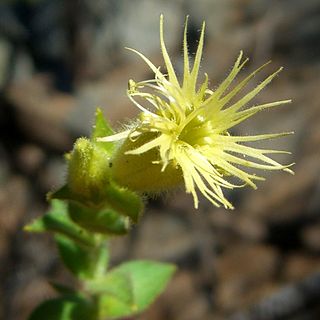
Silene parishii is a species of flowering plant in the family Caryophyllaceae known by the common name Parish's catchfly. It is endemic to southern California, where it is known from several of the local mountain ranges, including the San Bernardino, San Gabriel, and San Jacinto Mountains. It grows in rocky, forested habitat, sometimes in the alpine climates of the higher peaks. It is a perennial herb growing from a woody, branching caudex and taproot, sending up several decumbent or erect stems 10 to 40 centimetres tall. The oppositely arranged leaves line the stems, the largest ones located at the middle of each stem. Leaves are lance-shaped to nearly oval and up to 6 centimetres long. They are thick and leathery, and sometimes glandular and sticky. Each flower is encapsulated in a tubular calyx of fused sepals which may be nearly 3 centimetres long. It is greenish with ten veins and a coating of glandular hairs. The five petals are yellowish in colour and each has about six long, fringelike lobes at the tip.
Desmodium × humifusum is a species of flowering plant in the legume family known by the common names trailing tick-trefoil, eastern trailing tick-trefoil, and spreading tick-trefoil. It is native to the eastern United States, where it has been reduced to scattered populations in the states of Massachusetts, Connecticut, and Indiana. It once had a wider distribution but it has likely been extirpated from Delaware, Maryland, New Jersey, New York, Rhode Island, Virginia, West Virginia, and Missouri.















